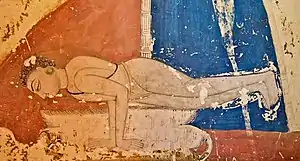Vasishtha Samhita
The Vasishtha Samhita (Sanskrit: वशिष्ठसंहिता, Vāsiṣṭha Saṁhitā, Vasishtha's Collection) is a 13th century medieval Vaishnavite text, one of the first to describe non-seated hatha yoga asanas including the arm-balancing Kukkutasana, Cockerel Pose. It makes use of the 10th century Vimanarcanakalpa, whose verse it paraphrases in prose to describe what may be the first non-seated asana, the arm-balancing Mayurasana, Peacock Pose. These descriptions in turn were exploited by the 15th century Hatha Yoga Pradipika.[1]

The Vasishtha Samhita describes non-seated poses such as Mayurasana. Mahamandir temple mural, Jodhpur, India, c. 1810
The text, ascribed to the earlier sage Vasishtha, was compiled by an unknown author of the Vaishnavite Shakta sect. Its 45 chapters cover peace, name-chanting, offerings, sacrifices, astrology, and donation.[2][3][4]
References
- Mallinson & Singleton 2017, pp. 87–88, 104–105.
- Joshi, Dinkar (2005). Glimpses of Indian Culture. Star Publications. p. 25. ISBN 978-81-7650-190-3.
- Frawley, David (2014). Vedic Yoga: The Path of the Rishi. Lotus Press. p. 150. ISBN 978-0-940676-25-1.
- Rosen, Richard (2012). Original Yoga: Rediscovering Traditional Practices of Hatha Yoga. Shambhala Publications. p. 264. ISBN 978-0-8348-2740-0.
Sources
- Mallinson, James; Singleton, Mark (2017). Roots of Yoga. Penguin Books. ISBN 978-0-241-25304-5. OCLC 928480104.
- Maheshananda, Swami; Sharma, B. R. (2005). Vasistha Samhita. Kaivalyadhama. ISBN 978-8189485375.
External links
- Sanskrit text of Vasishtha Samhita
- English prose translation by Manmatha Nath Dutt, Elysium Press, Calcutta, 1907
This article is issued from Wikipedia. The text is licensed under Creative Commons - Attribution - Sharealike. Additional terms may apply for the media files.
